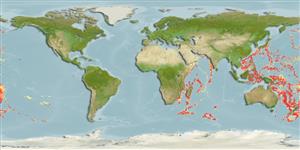Common names from other countries
Environment: milieu / climate zone / depth range / distribution range
Sinh thái học
; Mức độ sâu 850 - 2000 m (Ref. 76893). Deep-water
Indo-West Pacific: South Africa to Japan.
Length at first maturity / Bộ gần gũi / Khối lượng (Trọng lượng) / Age
Maturity: Lm ? range ? - ? cm
Found on clay substrates (Ref. 76893).
Life cycle and mating behavior
Chín muồi sinh dục | Sự tái sinh sản | Đẻ trứng | Các trứng | Sự sinh sản | Ấu trùng
Members of the order Decapoda are mostly gonochoric. Mating behavior: Precopulatory courtship ritual is common (through olfactory and tactile cues); usually indirect sperm transfer.
Baba, K., E. Macpherson, G.C. Poore, S.T. Ahyong, A. Bermudez, P. Cabezas, C.-W. Lin, M. Nizinski, C. Rodrigues and K. Schnabel. 2008. (Ref. 76884)
IUCN Red List Status (Ref. 130435)
CITES status (Ref. 108899)
Not Evaluated
Not Evaluated
Threat to humans
Harmless
Human uses
| FishSource |
Các công cụ
Thêm thông tin
Age/Size
Sự sinh trưởng
Length-weight
Length-length
Hình thái học
Ấu trùng
Sự phong phú
Các nguồn internet
Estimates based on models
Preferred temperature
(Ref.
115969): 2.8 - 5.5, mean 4 (based on 249 cells).
